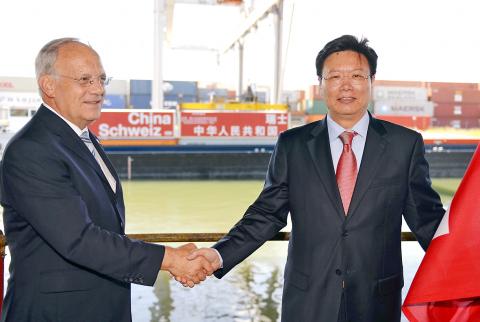A watershed free-trade deal between China and Switzerland came into force on Tuesday, the first such accord between the Asian giant and a mainland European economy.
Marking the start of the free-trade agreement, Swiss Economy Minister Johann Schneider-Ammann and Chinese trade envoy Yu Jianhua (俞建華) presided over a ceremony in the northern city of Basel.
“This is a real chance for Swiss and Chinese businesses alike,” Schneider-Amman told reporters.

Photo: EPA
“Our economy needs access to markets for its goods and services. The Swiss domestic market alone is too small for our economy and our labor market to prosper, and this is the consideration which shapes our foreign economic policy,” he said.
“I am convinced that both sides will benefit from this agreement,” he said, adding that Swiss industrial and farm goods would benefit from Chinese tariff cuts, while China’s industrial products would have duty-free access to Switzerland.
The deal also bolsters intellectual property protection for Swiss goods — a persistent concern for Western firms on the Chinese market, though Beijing has stepped up its battle against the pirates.
Yu, a key FTA negotiator and China’s ambassador to the WTO, agreed, saying: “This FTA is a historic step that will cement our economies.”
“It will also further help the process of reform and opening,” Yu added.
As the two officials looked on, a crane hauled a shipping container marked “Switzerland-China FTA” from a barge on the River Rhine, symbolizing Chinese imports, and loaded another in honor of Swiss exports.
The Rhine has long been landlocked Switzerland’s link to maritime commerce, with Basel still accounting for 40 percent of Swiss exports and 12 percent of imports. The FTA was signed in Beijing in July last year, capping two years of talks between China and Switzerland.
The deal is China’s second with a European country after Beijing signed an FTA with economic crisis casualty Iceland in April last year.
Neither Iceland nor Switzerland — whose prosperous economy emerged relatively undented by the crisis — is a member of the EU.
Beijing has been pressing Brussels for a similar FTA, but efforts on that front are more complicated because China would need to find agreement with the entire 28-nation bloc, and the two sides are locked in a series of tit-for-tat trade disputes.
The EU is China’s top export market, while China is second to the US as a destination for EU exports.
However, the balance is heavily in China’s favor.
While EU exports to China reached a record 148.1 billion euros (US$191.8 billion) last year, Chinese exports to the EU were worth 279.9 billion euros.
Switzerland has a relatively narrow trade deficit with China, its third-ranked partner after the EU and the US.
Last year, its exports to China were worth 8.8 billion Swiss francs (US$9.9 billion), and Chinese imports, SF11.4 billion.
Switzerland’s top exports to China are precision machinery, pharmaceuticals and chemicals and watches, while machinery and textiles head the list of imported Chinese goods.
With a strong Swiss franc and high labor costs making it hard to beat rivals on price, Swiss firms have long made quality their selling point.
The nation of 8 million people is dwarfed by behemoth China, but Yu said the deal represented an equal partnership.
“Switzerland is small. But small is beautiful. The small country is looking for a big market, but the big market, China, we are looking for the quality of the economy. We are upgrading our economy, we are looking for a partnership of quality,” he said.

To many, Tatu City on the outskirts of Nairobi looks like a success. The first city entirely built by a private company to be operational in east Africa, with about 25,000 people living and working there, it accounts for about two-thirds of all foreign investment in Kenya. Its low-tax status has attracted more than 100 businesses including Heineken, coffee brand Dormans, and the biggest call-center and cold-chain transport firms in the region. However, to some local politicians, Tatu City has looked more like a target for extortion. A parade of governors have demanded land worth millions of dollars in exchange

Hong Kong authorities ramped up sales of the local dollar as the greenback’s slide threatened the foreign-exchange peg. The Hong Kong Monetary Authority (HKMA) sold a record HK$60.5 billion (US$7.8 billion) of the city’s currency, according to an alert sent on its Bloomberg page yesterday in Asia, after it tested the upper end of its trading band. That added to the HK$56.1 billion of sales versus the greenback since Friday. The rapid intervention signals efforts from the city’s authorities to limit the local currency’s moves within its HK$7.75 to HK$7.85 per US dollar trading band. Heavy sales of the local dollar by

Taiwan Semiconductor Manufacturing Co’s (TSMC, 台積電) revenue jumped 48 percent last month, underscoring how electronics firms scrambled to acquire essential components before global tariffs took effect. The main chipmaker for Apple Inc and Nvidia Corp reported monthly sales of NT$349.6 billion (US$11.6 billion). That compares with the average analysts’ estimate for a 38 percent rise in second-quarter revenue. US President Donald Trump’s trade war is prompting economists to retool GDP forecasts worldwide, casting doubt over the outlook for everything from iPhone demand to computing and datacenter construction. However, TSMC — a barometer for global tech spending given its central role in the

The Financial Supervisory Commission (FSC) yesterday met with some of the nation’s largest insurance companies as a skyrocketing New Taiwan dollar piles pressure on their hundreds of billions of dollars in US bond investments. The commission has asked some life insurance firms, among the biggest Asian holders of US debt, to discuss how the rapidly strengthening NT dollar has impacted their operations, people familiar with the matter said. The meeting took place as the NT dollar jumped as much as 5 percent yesterday, its biggest intraday gain in more than three decades. The local currency surged as exporters rushed to